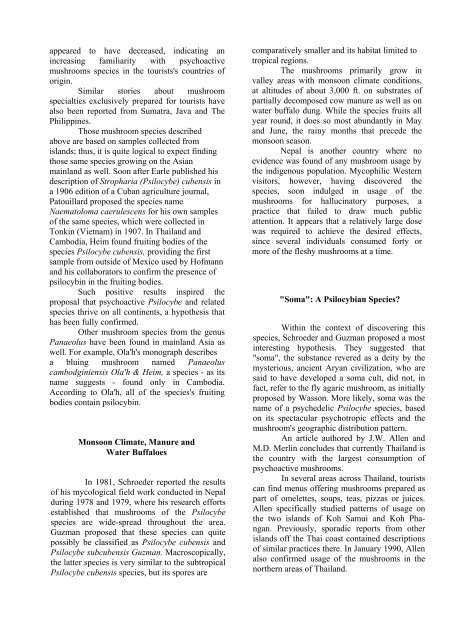Jochen Gartz - Magic Mushrooms Around the ... - preterhuman.net
Jochen Gartz - Magic Mushrooms Around the ... - preterhuman.net
Jochen Gartz - Magic Mushrooms Around the ... - preterhuman.net
You also want an ePaper? Increase the reach of your titles
YUMPU automatically turns print PDFs into web optimized ePapers that Google loves.
appeared to have decreased, indicating an<br />
increasing familiarity with psychoactive<br />
mushrooms species in <strong>the</strong> tourists's countries of<br />
origin.<br />
Similar stories about mushroom<br />
specialties exclusively prepared for tourists have<br />
also been reported from Sumatra, Java and The<br />
Philippines.<br />
Those mushroom species described<br />
above are based on samples collected from<br />
islands; thus, it is quite logical to expect finding<br />
those same species growing on <strong>the</strong> Asian<br />
mainland as well. Soon after Earle published his<br />
description of Stropharia (Psilocybe) cubensis in<br />
a 1906 edition of a Cuban agriculture journal,<br />
Patouillard proposed <strong>the</strong> species name<br />
Naematoloma caerulescens for his own samples<br />
of <strong>the</strong> same species, which were collected in<br />
Tonkin (Vietnam) in 1907. In Thailand and<br />
Cambodia, Heim found fruiting bodies of <strong>the</strong><br />
species Psilocybe cubensis, providing <strong>the</strong> first<br />
sample from outside of Mexico used by Hofmann<br />
and his collaborators to confirm <strong>the</strong> presence of<br />
psilocybin in <strong>the</strong> fruiting bodies.<br />
Such positive results inspired <strong>the</strong><br />
proposal that psychoactive Psilocybe and related<br />
species thrive on all continents, a hypo<strong>the</strong>sis that<br />
has been fully confirmed.<br />
O<strong>the</strong>r mushroom species from <strong>the</strong> genus<br />
Panaeolus have been found in mainland Asia as<br />
well. For example, Ola'h's monograph describes<br />
a bluing mushroom named Panaeolus<br />
cambodginiensis Ola'h & Heim, a species - as its<br />
name suggests - found only in Cambodia.<br />
According to Ola'h, all of <strong>the</strong> species's fruiting<br />
bodies contain psilocybin.<br />
Monsoon Climate, Manure and<br />
Water Buffaloes<br />
In 1981, Schroeder reported <strong>the</strong> results<br />
of his mycological field work conducted in Nepal<br />
during 1978 and 1979, where his research efforts<br />
established that mushrooms of <strong>the</strong> Psilocybe<br />
species are wide-spread throughout <strong>the</strong> area.<br />
Guzman proposed that <strong>the</strong>se species can quite<br />
possibly be classified as Psilocybe cubensis and<br />
Psilocybe subcubensis Guzman. Macroscopically,<br />
<strong>the</strong> latter species is very similar to <strong>the</strong> subtropical<br />
Psilocybe cubensis species, but its spores are<br />
comparatively smaller and its habitat limited to<br />
tropical regions.<br />
The mushrooms primarily grow in<br />
valley areas with monsoon climate conditions,<br />
at altitudes of about 3,000 ft. on substrates of<br />
partially decomposed cow manure as well as on<br />
water buffalo dung. While <strong>the</strong> species fruits all<br />
year round, it does so most abundantly in May<br />
and June, <strong>the</strong> rainy months that precede <strong>the</strong><br />
monsoon season.<br />
Nepal is ano<strong>the</strong>r country where no<br />
evidence was found of any mushroom usage by<br />
<strong>the</strong> indigenous population. Mycophilic Western<br />
visitors, however, having discovered <strong>the</strong><br />
species, soon indulged in usage of <strong>the</strong><br />
mushrooms for hallucinatory purposes, a<br />
practice that failed to draw much public<br />
attention. It appears that a relatively large dose<br />
was required to achieve <strong>the</strong> desired effects,<br />
since several individuals consumed forty or<br />
more of <strong>the</strong> fleshy mushrooms at a time.<br />
"Soma": A Psilocybian Species<br />
Within <strong>the</strong> context of discovering this<br />
species, Schroeder and Guzman proposed a most<br />
interesting hypo<strong>the</strong>sis. They suggested that<br />
"soma", <strong>the</strong> substance revered as a deity by <strong>the</strong><br />
mysterious, ancient Aryan civilization, who are<br />
said to have developed a soma cult, did not, in<br />
fact, refer to <strong>the</strong> fly agaric mushroom, as initially<br />
proposed by Wasson. More likely, soma was <strong>the</strong><br />
name of a psychedelic Psilocybe species, based<br />
on its spectacular psychotropic effects and <strong>the</strong><br />
mushroom's geographic distribution pattern.<br />
An article authored by J.W. Allen and<br />
M.D. Merlin concludes that currently Thailand is<br />
<strong>the</strong> country with <strong>the</strong> largest consumption of<br />
psychoactive mushrooms.<br />
In several areas across Thailand, tourists<br />
can find menus offering mushrooms prepared as<br />
part of omelettes, soups, teas, pizzas or juices.<br />
Allen specifically studied patterns of usage on<br />
<strong>the</strong> two islands of Koh Samui and Koh Phangan.<br />
Previously, sporadic reports from o<strong>the</strong>r<br />
islands off <strong>the</strong> Thai coast contained descriptions<br />
of similar practices <strong>the</strong>re. In January 1990, Allen<br />
also confirmed usage of <strong>the</strong> mushrooms in <strong>the</strong><br />
nor<strong>the</strong>rn areas of Thailand.








![The Big Lie 9-11 and Government Complicity in Mass Murder [PDF]](https://img.yumpu.com/50957077/1/190x245/the-big-lie-9-11-and-government-complicity-in-mass-murder-pdf.jpg?quality=85)








